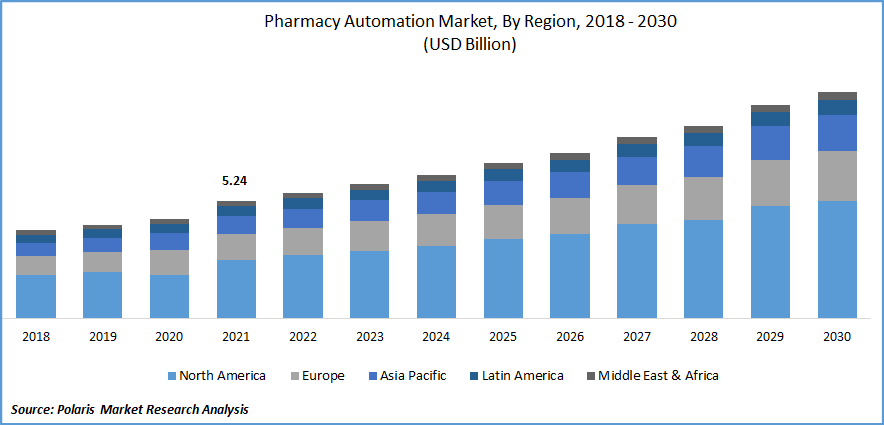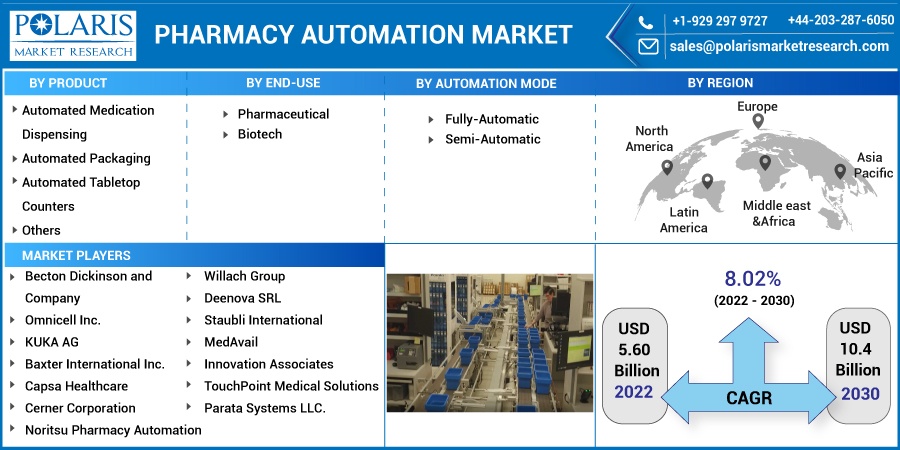
Pharmacy Automation Market Share, Size, Trends, Industry Analysis Report, By Product (Automated Medication Dispensing, Automated Packaging, Automated Tabletop Counters, and others); By End-Use; By Automation Mode; By Region; Segment Forecast, 2022 - 2030
- Published Date:Nov-2022
- Pages: 117
- Format: PDF
- Report ID: PM2802
- Base Year: 2021
- Historical Data: 2018-2020
Report Outlook
The global pharmacy automation market was valued at USD 5.24 billion in 2021 and is expected to grow at a CAGR of 8.02% during the forecast period.
Rapid growth in the focus on automation for several different purposes, such as reducing labor costs and increasing specialty drug dispensing systems, are the major factors projected to drive the growth of the global market during the forecast period. Moreover, rising adoption of various types of advanced robots coupled with growing government efforts to promote industrial development and a rapid surge in demand for IoT in pharmaceutical manufacturing units across the globe are also likely to fuel the growth and demand for the market over the coming years.

Know more about this report: Request for sample pages
Furthermore, an extensive rise in the demand for vaccines for several chronic disorders and a rising number of patients admitting and opting for hospital facilities due to their increased spending capacity in the healthcare sector coupled with the continuous introduction to many new and innovative automation devices by large market companies globally is anticipated to contribute significantly to the global market growth during the forecast period.
For instance, in 2021, Innovation Associates introduced its SmartPod, a robot for centrally filled pharmacy environments. The newly launched product enables service and solutions providers to scale and adjust their centralized fulfillment to meet the growing demands. However, the high cost associated with the implementation of pharmacy automation systems and various stringent regulations, which can impact product launches, is a few key factors projected to hamper the growth of the global market throughout the forecast period.
The global outbreak of the COVID-19 pandemic has positively impacted the growth of the market. Increased global demand for testing and production products has resulted in higher growth for various automation solutions globally. In addition, rapid growth in the adoption of robotics and automated systems by several pharmaceutical companies for enhanced and automated testing of COVID-19 also had a positive impact on the growth of the market.
 Know more about this report: Request for sample pages
Know more about this report: Request for sample pages
Industry Dynamics
Growth Drivers
Growing focus on minimizing medication errors as medication errors are recognized as a major cause of several hospital readmission worldwide, coupled with the growing technological advancements in healthcare infrastructure, mainly in emerging economies including China, India, and Indonesia, are key factors expected to drive the growth of the global market over the forecast period. Automated solutions are one of the most efficient and accurate solutions to reduce these errors, which has resulted in higher adoption of these technologies across the globe.
Report Segmentation
The market is primarily segmented based on product, end-use, automation mode, and region.
|
By Product |
By End-Use |
By Automation Mode |
By Region |
|
|
|
|
Know more about this report: Request for sample pages
Automated medication dispensing dominated the market in 2021
In 2021, automated medication dispensing systems were the leading segment with a significant market share. The growth of the segment market is majorly driven by better dispensing of medicines and enhanced safety and security offered by these systems, which helps reduce wrong medications being dispensed to the patients. For instance, according to a report published by StatPearls, around 9,000 people die every year due to medication errors, and the cost associated with these errors in the management of patients amounts to more than USD 40 billion annually.
Moreover, the automated medication compounding systems segment is expected to grow at fastest growth rate over the forecast period. The increasing need for these automated systems to reduce or nullifies the chances of manual errors, which can result in drastic effects, is a key factor anticipated to propel the growth and adoption of automated medication compounding systems across the globe over the coming years.
Pharmaceutical segment accounted for the largest market share in 2021
The largest market share of the global market was held by pharmaceutical segment in 2021, which is mainly attributed to growing adoption of continuous improvement processes for improving production flexibility, product efficiency, and reducing wastage in manufacturing processes around the world.
In addition, several prominent technology players in the market such as Microsoft Corporation, IBM Corporation, and Google, are highly engaged in the developing automation process. Cloud solutions for the healthcare sector to fill the security gaps and provide better protection to production networks are also likely to boost the growth of the segment market rapidly in the coming years.
However, the biotech industry is witnessing fastest CAGR during the forecast period owing to increasing focus on developing new products, new production, and manufacturing methods, and growing efforts to improve the existing ones across the globe. Moreover, rising investments in sustainable high technology like biotechnology in many developed countries, including Germany, France, and United States, are likely to fuel the segment growth at a significant pace over the forecast period.
Fully-automatic sector is expected to hold the significant revenue share
The fully automatic segment is anticipated to witness rapid growth over the forecast period; the growth of the market is mainly attributed to the rising installation of various complete automation solutions in end-use industries like chemicals & materials, oil & gas, and metals & mining. A rapid surge in the usage of advanced robots and automated systems across the globe, which helps to assist the human workforce in many different high-intensity tasks, has paved the way for lucrative growth opportunities for the next coming years.
The demand in Asia Pacific is likely to grow at fastest rate during the forecast period
The increasing geriatric population, reduction in medicine manufacturing costs, and improved and proper management of workflow in several hospitals, especially in developing economies such as India, China, and Indonesia, are major key factors expected to drive the growth of the pharmacy automation market exponential in the region over the coming years. In addition, rising prevalence of advanced healthcare technology solutions, along with the growing number of large market companies setting up their production facilities in the region, is also likely to propel the growth of the regional market at a significant growth rate.
Furthermore, North America dominated the pharmacy automation market in 2021 and is projected to maintain its position throughout the forecast period owing to high advancement in patient management systems and highly developed healthcare systems in the region. Growing efforts by major manufacturers of medicines to minimize wastage of medicines as well as reduce cost has also been influencing the growth of the pharmacy automation market.
A wide range of leading market players, such as Becton Dickinson and Company, Capsa Healthcare, and Baxter International Inc., is also propelling the region’s growth. Moreover, growing need to reduce medication errors in healthcare sector in the region is also influencing consumers to opt for advanced automated systems. For instance, according to the US Food and Drug Administration, each year, over 100,000 cases of suspected medication errors are reported in the United States.
Competitive Insight
Key players in the global market are Becton Dickinson, Omnicell, KUKA, Baxter, Capsa Healthcare, Cerner Corp., Noritsu Pharmacy Automation, Willach Group, Deenova, Staubli International, MedAvail, Meditech Pharmacy Management, Innovation Associates, TouchPoint Medical Solutions, and Parata Systems.
Recent Developments
In March 2022, Capsa Healthcare, US announced the expansion of its product “NexsysADC”. The new automatic dispensers are enabled to accommodate any size of controlled and supplies in 2 new sizes of the controlled module drivers.
In December 2021, Omnicell Inc., acquired of ReCept Holdings Inc., a specialty pharmacy management services provider, for a value of USD 100 million. With this acquisition, the company will be able to broaden its offerings in specialty pharmacy management services.
Pharmacy Automation Market Report Scope
|
Report Attributes |
Details |
|
Market size value in 2022 |
USD 5.60 billion |
|
Revenue forecast in 2030 |
USD 10.4 billion |
|
CAGR |
8.02% from 2022 – 2030 |
|
Base year |
2021 |
|
Historical data |
2018 – 2020 |
|
Forecast period |
2022 – 2030 |
|
Quantitative units |
Revenue in USD billion and CAGR from 2022 to 2030 |
|
Segments Covered |
By Product, By End-Use, By automation Mode, By Region |
|
Regional scope |
North America, Europe, Asia Pacific, Latin America; Middle East & Africa |
|
Key Companies |
Becton Dickinson and Company, Omnicell Inc., KUKA AG, Baxter International Inc., Capsa Healthcare, Cerner Corporation, Noritsu Pharmacy Automation, Willach Group, Deenova SRL, Staubli International, MedAvail, Meditech Pharmacy Management Solutions, Innovation Associates, TouchPoint Medical Solutions, and Parata Systems LLC. |
